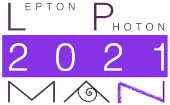Speaker
Description
In the Standard Model, the Higgs boson can decay invisibly only through two Z bosons further decaying to neutrinos. The branching ratio for this process is predicted to be very small. However, in some Beyond Standard Model (BSM) theories, the Higgs boson can also decay to weakly interacting particles, candidates for Dark Matter (DM), that can not be detected by the ATLAS detector and arise as missing transverse momentum (ETMiss) in the events. Studies are presented for a search for an excess in events with two electrons or muons and ETMiss sensitive to DM decays of the Higgs boson if the Higgs boson is produced in association with a Z boson. The analysis is performed using proton−proton collisions at a centre-of-mass energy of 13 TeV, delivered by the LHC, corresponding to an integrated luminosity of 139 fb−1 and recorded by the ATLAS experiment. Results are interpreted as an upper limit on the branching ratio of the Higgs boson to invisible particles and exclusion limits are also set for simplified Dark Matter models and 2HDM+a models.
